Vedanta Sandesh



The cover page of the Dec 2022 issue of Vedanta Sandesh is a small, cute and very colorful bird - the Crimson-backed Sunbird (Leptocoma minima). This sunbird is endemic to the Western Ghats of India.

Crimson-backed sunbirds are tiny, even by sunbird standards, and are only 8 cm long. The adult male is velvety red on the mantle and wing coverts and there is a broad red breast band. The crown is shiny green and there are pink-violet patches on the throat and rump. The underside from the breast below is yellowish. They have medium-length thin down-curved bills and brush-tipped tubular tongues. The female is olive-brown but the rump is distinctly red. They are attracted to flower-rich gardens at the edges of forests or plantations. They feed mainly on nectar.
These bird are extremely beautiful, as though the blessed creator has taken a brush and painted them personally & meticulously. Seeing the beauty of creation is the best way to sing the glories of God.
Om Namah Shivaya.
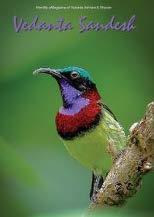



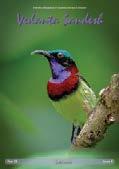

Among the various means necessary for liberation, devotion (bhakti) stands supreme. Devotion is constant contem plation of one‘s own Real Nature.



In his introduction to Bhagwad Gita, Bhagwan Sri Adi Shankaracharya in his Bhashya enlightens us about Dharma. What is after all Dharma. Let us brief ly discuss here as to what does he say about this subject.
What Dharma is not : Before we go into it, let us first discuss as to what Dharma is not. Someone translated Dharma as Religion or Majhab. Whoever

translated it in this way, has not only re vealed his profound ignorance about the term and understanding of Sanatan Dhar ma, but has also done immense harm to the very understanding of the subject, and in the process a very beautiful fact of life. Unlike the various religions and sects, Dharma is not a package of do’s & dont’s to be followed religiously & ritualistically, even though do’s & dont’s may be ini tially the way to go for non-initiates in the beginning, so that they may start to live a healthy life. Thoughtless ritualism is never Dharma. Dharma emanates from some understanding of life which translates into a unique ‘art of living’, which facilitates a healthy living in the world and helps us to
“There may be many religions & sects, but in & all these there is just one timeless Dharma. ”
be holistically healthy and complete. We may not initially know the transcenden tal, but a Dharmic person has faith in the existence of a supreme divinity and with this exudes the fragrance of well-being & completeness.
Dharma is God-centric way of living.
Before introducing the meaning & impli cation of the word ‘Dharma’, Sri Sankara in his Bhashya introduces us to Ishwara, because basically Dharma is a God-cen tric art of living, and therefore it is proper that we start the process of understand ing Dharma with Ishwara. The Acharya says that in the beginning of creation there was just a transcendental, non-du al, infinite & timeless divinity - blissful, self-effulgent existence. The story of creation started from there,

and it will be extremely pertinent that we remain conscious of this fact. This is what the Upanishads call Brahman - the truth of everyone and creation. He wished to be manifested in multiple forms, and lo, he did. First there was the wish, then a clear thought of how the creation needs to be, and then from this thought crystalized the gross, manifested creation. The creation is all about donning up the different forms - by Ishwara. As there was nothing else, so he alone was the instrumental cause (Nimitta Karana), and he alone was the material cause (Upadana Karana). Ish wara is therefore referred to in the Vedan ta as Abhinna Nimitta Upadana Karana, meaning one who is simultaneously
both
“Objective of Dharma is to help us live a healthy & productive life, but basically prepare us to wake up to the timeless truth.. ”
the instrumental and material cause of the creation. In simple terms it means that HE alone presents himself as the creation, and not that he sits somewhere else and creates the world. No wonder it is so beau tiful & awesome. You dive deep into any thing and you discover Ishwara. No won der people become poets just seeing this beautiful creation.
Dharma is to get the best of our lives.

Having created the universe with all its multiplicity and different beings, he then created humans. There is a pro found difference between these two categories of cre ation - humans and non-hu mans. While all other be ings are programmed to do something and shall always
remain in that domain, humans are initially also bound by their prakru ti, but also have freedom to go beyond its clutches and lim itations, and thus wake up to the transcendental. Man is therefore free, and with freedom comes the possi bility of either going up or even down. Whenever there is a very complex and unique creation, with the possibility of its use & abuse, we always get an instruction manual which helps us to use it properly & optimally to get the best out of it. That is why God gave us Dharma Shastra.
Acharya says that Dharma basically helps us to attain our Abhyudaya and also Nishshreyas. Abhyudaya means tak

ing care of our worldly well-being, be it earning wealth (Artha) or be it enjoying a moment (Kama). When a conscientious person truly takes care of his or her basic securities and well-being then such a per son is never a nuisance to others around. When there are people who live as per such philosophy, then the world runs prop erly and God too is happy. The world is his beautiful creation, his love, his art and we all know how awesome it is, and no won der he wants an assurance that it continues unabated to bless one & all. A dharmic person lives holistically for the well of all.
The basic difference between a ‘dhar mic’ way of life and an ‘adharmic’ way is the state of mind of a person. Because of

“Dharma helps us to attain Abhyudaya (worldly well-being), as well as Nishreyas (Moksha). ”
the awareness of Ishwara, a dharmic per son is never alone, and therefore there is no anxiety about his/her self. There is not only a sense of security but also a bless edness of being a creation of & by God. Not only God has created us and gifted us this unimaginably beautiful life & world, the human body, the human mind and all the loving people etc, but he alone is as suring our continuity, he alone brings Kar ma-phala and helps to fulfill ours dreams. So we feel blessed by someone divine, and our life too is basically to serve and live for him - lovingly. On the other hand, a person who is not conscious and sensi tive of all these facts, is basically a very insecure person, all the burden of life and its achievements lie on his shoul ders, he or she is basically very lonely, alone, and therefore lives for his own well-being. This is what self-cen

tricity is all about. Because of the lack of proper understanding of life they have no option except to live a selfish way of life. Their love is just for Me & Mine. They live in a very small world. Given an option they will choose just their self-interest and will never care for all. Such people get swept away in their self-interest and therefore are never steady & reliable.
Mahabharata summarizes this truth of life by its diktat that - Yato dharmah tato jayah - Where ever there is Dhar ma, there shall be victory & well-being.
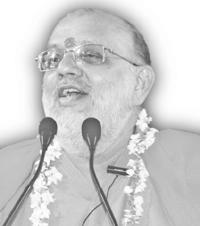




‘Drig Drishya Viveka’ is one of the most significant and popular treatise of Advaita Vedanta. It is also known as ‘Vakya Sudha’. It is a ‘Prakarana Grantha’ which means, it deals with a specific aspect in the journey of discovering oneness be tween Jiva and Brahman, that being a distinction between the ‘Seer and the seen’. It is a very precise text which has
31 shlokas. Although some publications have 46 shlokas, the validity of which has been a subject of debate? Since many Vedantic Acharyas doubt the seamless flow of thoughts between the two hence we will also be seeing the completion of the grantha at 31st shlokas.
The author of the text is also a subject of debate amongst scholars. Although this text is popularly seen as written by Sri Adi Shankaracharyaji, yet looking at the style in which the text has been written many Scholars have a different opinion. Some say the style of writing is that of Vidyaran ya Swamiji and so it is written by him. Vid yaranya Swamiji too comes in the same Vedantic lineage of Teachers and is high ly revered in the Vedantic Parampara. In any case the validity of knowledge com ing down from the Upanishadic Parampa

ra has always been of utmost priority and this treatise is a clear reflection of it. The Authors too uphold the significance of the Upanishads as being the being the source of knowledge rather than the importance of an individual. This has always been the beauty and dignity of Sanatan Dharma. Having looked into this outline we will now try and understand the anubandh cha tushtaya of the text.
Anubandh Chatushtaya is the four-fold consideration which inspires a person to read or study a particular book or granth. For example before taking up a book to read one may ask-What is the objective of reading the book, who is the de serving person to read the book, what is the subject matter of it and what will be the objec tive that will be fulfilled on
reading it. In Vedanta understanding the anubandh chatushtaya of a scripture or treatise is of utmost importance and can not be missed before entering into the text. Many authors may present this direct ly in the very first shloka and if not, then too the Acharya teaching the subject surely reveals it to his students before diving into the main text. So here too we shall first look into the anubandh chatushtaya of ‘Drig Drishya Viveka’.
Drig Drishya Vivek is a treatise of Advai ta Vedanta and so here the qualified student of Vedanta is one who has seen the futility of worldly experiences. Hav ing gone through various experiences of worldly interactions he has realized that in spite of repeated indulgence in world ly experiences contentment is still beyond

the horizon. Everything experienced with in the realm of time, space and object is ephemeral in nature. And thus the ques tion if everything in the world is imperma nent then what is permanent and how can I be truly fulfilled? With this kind of dis tinctive enquiry between the permanent and the impermanent such a person de velops a dispassion towards the material world and is inspired by self-enquiry. The Scriptures reveal that continuous seeking in the world is a consequence of illusory self-perception. I see myself as a limited entity whose contentment lies elsewhere. Seeing the Self as a limited being is the road to continuous and endless seek ing. It is only when a person is cu rious to enquire on the truth of the Self and is disinterested in the worldly pleasures and at the same also has
a mind that is subtle, integrated and pure that he is said to be a deserving student of Vedanta. Vishaya (Subject):
As the name of the text suggests the subject matter of the text is a discrimina tive enquiry between the ‘Seer’ and the ‘Seen’. The entire spectrum of manifested existence can be classified into the Seer and the Seen, the Subject and the object, or the Self and the non-Self. The world of the ‘Seen’ is everything that can be ob jectified and perceived by the ‘Seer’ as other than the Seer or the Self. The Self is the Seer. Discovering the reality of the Self or the Seer is the subject matter of Vedan tic philosophy. The perception of my Self today is erroneous based on misapprehension of the Self. I see myself as a man ifested being limited in time and space,
a jiva who’s source of contentment lies somewhere outside in worldly experienc es. Whereas the scriptures reveal to us the true nature of the Self as being beyond the realms of time and space. There is a truth that exists even when there is no con cept of time and no limitation of space. When there is no experience, object of experience and the experiencer. That un conditional pure existence is my Real Self. But awakening in this true nature of the Self is a journey of discrimination. A jour ney of discrimination between the ‘Seer and the Seen’, the ‘Self and the non-Self’. This discrimination is the subject matter of this enlightening text called ‘Drig-DrishyaViveka’. This is a journey between self per ception and the reality of the self.
Sambandha : Sambandha is the relationship between
the text and the subject matter. Here it is ‘pratipadya pratipadak sambandha’ which means exposition of knowledge alone will help us realize the goal. There is no role of karma or any other sadhanas, as all sadhanas come in the realm of karma.
It is the goal that will be fulfilled by study ing this subject matter. Here in this context it is discovering the Real nature of the Self which is limitless and free of all limitations of time, space and object.
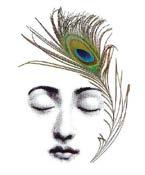

Q: Why does a person compromise, why does someone do evil things?
Hari Om.
Arjuna also asked a similar question to Bhagwan Krishna in the third chapter of Bhagwat Gita. It is a question of great importance to the majority.
Before we go into ‘why do we do adhar ma’, we should bring to our mind as to

‘when do we do dharma’. In treading the path of dharma basically there is no self-concern, it could be just love, devotion, gratitude etc. All these indi cate that we are inspired to serve some person or a cause. There is an under standing that my requirements are be ing taken care of, and I am free from the burden of self-concern. This is easily done by our belief in the existence and benevolence of God. He has already blessed us with so much that we cant basically even imagine. He is still doing it every moment of our lives. He doesn’t even want any reciprocation for himself, he is a magnanimous giver,

however appreciating his order of the things we just tune ourselves in and be his instrument. This attitude springs from a heart felt feeling of the existence of God. On the other hand, a non-believer has all the burden of the security & well-being of his life on his own head. There is a lack within, there is loneliness and in security too. All this prompts a person to live a self-centric life. The criteria of righteousness is their likes & dislikes. Few things I like and some I dont, this alone is the guiding principle to tread the jour ney of this life. Satiation of likes is hap piness and the flip side is that if we get anything as per our dislike then it is sorrow. Now, if we see closely when the
likes & dislikes rule the roost, then there is neither any need for any philosophical appreciation of life, nor even the feeling for something. The fundamentals are as though clear. In the process the intellect doesn’t blossom, and in fact self-concern makes it dull.
In the 3rd chapter Bhagwan says that our Kama & Krodha is Gyan-Vigyana nashanam. It is something which robs us away of our subtle wisdom and power of introspective thinking. So whenever we are devoid of any ‘blessed feeling’ and at the same time we have dozens of insecurities, the re sult is the desperate attempt to follow our likes rather than tread any dharma, which doesn’t yet make any sense. That

is why we compromise. So Gita saysKama eshah, Krodha eshah - which is the cause of our compromise and treading the path of adharma.
Love & om Swami Atmananda

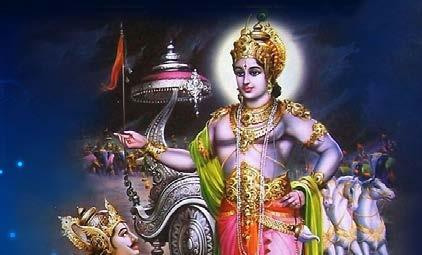

( Gita Ch. 16 / Shloka 23 )

He, who having caste aside the ordinances of the Scriptures, acts under the impulse of desire, attains neither perfection, nor happiness, nor the Supreme Goal.
(Gita Ch 16 / Shloka 23)
One who has caste aside the ordinanc es of the Scriptures. Having created the srishti ‘Shastra’ is a gift that Ishvara has given to mankind. Apart from a human being all the living beings in the universe live as per the pro gramming that God has designed. A ti ger will live exactly the way it has been programmed to live wheather it is in this

age or thousands of years ago. So also all other beings, live in a conditioned man ner. It is only a human being who has the freedom to think and discriminate, he has the freedom to perform actions as per his discrimination, a mind that can desire, feel and express. Apart from this, on one hand where all other living beings live to fulfill the ba sic needs of food, shelter and progeny, man alone is the one who can evolve as a conscious being. He can awaken in the realms of his innermost truth. In this manner having created ‘Man’ with a unique freedom to do or not to do or even to do otherwise, Bhagwan in or
“Where all other living beings live to fulfill the basic needs of food, shelter and progeny, man alone can evolve as a conscious being.

der to sustain the creation in perfect health and harmony, He gifted man with a parting gift and that is the Shastras-The Vedas. The Vedas are the ultimate valid means of knowledge which gift us with two branches of knowl edge, the Dharma Shastras and the Upanishads. The section on Dharma teaches us the art of right eous living which is living a God-cen tric life as his divine instrument. Upani shads or Vedanta is the knowledge of detachment from worldly seeking and awakening in the truth of the Self. The art of righteous living has been gloriously gifted to us by Sri Krishna himself in Sri madBhagwadGeeta.
SrimadBhagwadGeeta is a Dharma Shastra which teaches us the art of liv

ing a holistic life in harmony with the entire creation. The basis of such an at titude being the attitude of seeing the presence of Ishvara in and through all the macro and micro existence.
In modern day society the philosophy of life is focused only on individual profit and loss ignoring the holistic welfare of all living and non-living beings, the con sequences of which we can see in the stress of human life and the destruction of mother nature.
“
B
hagwad Geeta is a manuscript of a holistic art of God-centric living. ”

Thus Srimadbhawadgeeta is a man uscript of a holistic art of God-centric living that en velopes the welfare of one and all. It is only due to the ignorance of this knowl edge that a human being
has developed lop-sided priorities and means to fulfill them. In his ignorance of this art of living Man is on a road map of self-destruction.
Vartate kaam kartah: acts under the impulse of desire. In the following shloka Bhagwan says, if one were to ignore the guidance of the Geeta and only live a life motivat ed by one’s Vasanas and likes and dis likes, ignoring the Creator’s presence and blessings then Man is doomed to bring about his downfall. Revelling in self-centric pleasures his mind will become insensitive and inert.
Na cha siddhim avaapnoti: attains neither perfection. The mind of such a human

being engrossed in the pains and pleas ures of worldly experiences will only be malligned with more layers of Vasanas, raag and dvesha, insensitivity, and un gratefullness towards the Creator of this universe. He will not attain the ‘siddhi’ of a pure, integrated and subtle mind.
Na sukham na paraam gatim: nor happiness, nor the Supreme Goal. He will neither be at peace with himself nor will he bring any peace to anybody around him. Na paraam gatim-The ultimate goal of human life is to discover self contentment, to discover oneness with Ishvara. There is no possibility either for such a person to be available for a higher goal in life of awakening in one ness with Ishvara or Self-knowledge.
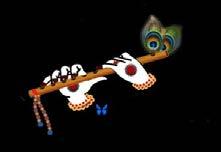

Geetacharya feels that he has not expressed all the implications of a Karma-Yogin’s egoless attitude and so he adds, “The one pursuing Karma-Yoga, re jecting the fruit of action, attains peace, born of his steadfastness; the one not pursuing Karma-Yoga led by desires, gets bound-as he becomes attached to the fruit of actions. On undertaking all activ ities in a spirit of dedication, his Vasanas

exhaust and his mind gains in its inner content of peace and joy: he is no more anx ious of the future-indicated here by the term “fruits of actions”. This is for one who is steadily serving the world as a worship of the Lord - who is serving in the spirit of Yagna- who is noted in his ideal of ado ration. One who has no ideal, no altar and no dedication, he, prompted by his ego centric desires, selfishly anxious of the fu ture results, in his attachment, becomes bound and gagged. Thus, by undertaking all activities in the Yagna spirit all Vasanas exhaust themselves. Mind be comes clean and it comes to enjoy its meditative poise, when it gains intuitive perceptions of the real all-pervading Self. “Man is more anxious of the future-indicated by the term ‘fruits of actions’. ”

Such an individual, who has brought his subjective life under his own control, is called “sub-du er”. To him it is evidently clear that he acts not in the throb of the buzzing activities of his body, mind and intellect. The Sun acts notbut the world of beings drawing energy from the Sun, each acts according to one’s own tendency. Like the Sun the Self, as Pure Con sciousness witnesses all activities of the personality layers in everyone. Declares Krishna: The one who has subdued his per sonality, having renounced all sense of agency in actions by discrimination, rests happily in the city-of-nine gates, neither acting nor causing actions in others.
“An individual who has subdued his out going personality”, “through his discrim
inative understanding” comes to recog nise that there is no sense of agency in him in all the actions, “he comes to live happi ly” in his body the nine-gate city.
The body is called the capital city where the ego has its palace-is fortressed by the physical body, with nine gateways for transactions with the world outside. The mouth, 2 nostrils, 2 eyes, 2 ears, one anus, one genital opening-together nine open ings are there in every physical body. They are guarded well, and at night, in sleep, all are closed. In this city the Lord Self lives “neither acting nor causing actions in others”. By Its mere presence, It blesses all and everyone acts for the glory of the Kingdom.
“
Self is Pure Consciousness, in whose presence the equipment’s get thrilled into actions.


The man who has successfully subdued his entire outgoing personality realises, in his inward pursuits of meditation, that as Self, he is Pure Consciousness, in whose pres ence the equipments get thrilled to actions.
In such an egoless attitude, the noblest of activities gush out from the inspired saint. It is from actions, flooding from such deper sonalised ones, that the world of spirit and science, of adventure and conquests, of politics and economics had gained all its growth and development. We all owe our today’s progress and civilization, science and culture, law and order, inventions and discoveries to men working in this eg oless attitude of inspiration with a touch of divine creativity. With such egoless action our youth can remake the tottering world around them.
For this rebuilding of the human society, never was the world so ready and so con ducive, ever before. Quick transport, easy communication channels, world-wide or ganisations, production centres that can supply anything, in any quantity, within the shortest time-interval-no doubt, never before was man so well-provided to at tempt a re-building of his society. But are the youth ready? Have they the required inspiration in them- selves to re-build the world around them? Of course they have a blind ram-force, which other elderly mis chief-mongers can wield but have the youth the necessary knowledge, the re quired vision, the sufficient inspiration, and
“Geeta is emphatic that without this egoless mood, such a national reconstruction and world readjustment cannot be undertaken successfully.

the adequate physical readiness to strike? Have they the alert mental preparedness to strive, in spite of repeated initial failures and disappointments? Have they trained to sink their individuality their ego-to act ego- lessly, selflessly ?-I don’t know...
But Geeta is emphatic that without this egoless mood, such a national reconstruction and world readjustment can not be under-taken successfully. a mighty chance awaits the modern youth. Live the Geeta way of life and ex pand your powers, in- crease your strength, re-inforce your mental personality. Bring these wealths within you to serve the world, to revolutionise life and its present decadent values.



The soul is God. It alone is Truth. It is without a second. It is what gives life to the body, the senses, and the mind. Like the sky it exists everywhere and in everything. It is unlimited by time and space. It is self-luminous and is the em bodiment of Knowledge, Existence, Bliss. None can deny it. The most careful ob servation of natural laws, the speediest progress of science, the newest and the

most valuable discoveries-none of these can repudiate the existence of God. On careful thought we can see that the discoveries of natural science only prove and not disprove the existence of the soul. If anyone thinks otherwise, it is nothing but his folly. That I am not this in ert, earthlike mass of flesh, five or six feet long, but the soul, the embodiment of life, is a truth which can never perish. It was so in the past, it is so in the present, and it will be so in the future.
Out of personal experience the Rishis have sung, “These bodies of the Indwell ing Self are all perishable,” and even now Holy men have direct experience of Truth. If some are yet tempted to dis believe such testimony and regard it a mere figment of the imagination like the proverbial “rabbit’s horn,” It will not

become nothing. We can only say that such people are blinded by their own sin. The frogs in the well will assert with all the force at their command that there is no sea-the magnificent, shoreless sea with mountainlike waves sweeping its surface. Notwithstanding all their deni al, the deep-blue ocean rolls on. Let the West deny the existence of God and soul if it will. For it, that is but appropriate. But for this Holy Motherland of ours, which once resounded with the voice of the great Saints who sang of the immor tality of the Soul. Such views are entirely unsuited. It is not enough if we discoun tenance such atheistic tendencies; we should sweep them clean out of our Holy land. For us, children of the great Rishis, faith in ourselves, knowledge of the soul, and Soul-force are ours by birth
right. It is our paramount duty not to waste that spiritual heritage but to keep it and increase it for ever more.
Remember this: even when this body composed of the five elements decomposes, the life that illuminates it and ac tivates it does not perish. That life is the Soul. That Soul is yourself. Believe this firmly. Save your faith from the invasion of atheistic creeds. That faith must be within you. Kindle that spark into a nev er-dying flame! Remember your ances tors, the great Rishis, who, steeped in ever lived in bliss. Bow down your heads in loving reverence before the Himala yas, their dear abode. Detach yourself from this body which may perish today or tomorrow; believe in the immortal Soul and acquire Soul-force and there by bless yourself; bless others; bless all
the world and reclaim it from all disabil ity. May you become bejewelled bea cons of inextinguishable spiritual light! May the Divine Himalaya, father-in-law of Lord Parameshwara, bless you!
To the materialist, the snow-clad peaks of the Himalayas are earthly. Their beau ty is earthly; the joy they kindle is earthly. But to me, the peaks, their beauty, and the joy they evoke are all Divine. Enjoy ing that supermundane experience, I continued my journey.



Amongst the many characters in the Mahabharata, the impetuous Ashwathama comes across as a warrior lacking maturity and forethought. He of ten finds himself in difficult situations as he jumps headlong without assessing his capacity and strength.
Known to punch above his weight, he relegates the mighty Brahmastra to just another arrow in his quiver.

His ego is such that he believes he can even get hold of the Sudarshan Chakra, which is next on his list of weapons to ac quire. His belief in his ability and the ar rogance that defines him compels him to think that for a warrior of his stature, the Sudarshan Chakra should ideally be with him and not with Krishna.
To fulfil his desire, he travels to Dwarka and meets Krishna. He thinks that by ac quiring the chakra, he can be mightier than Krishna himself.
‘O Krishna, I have every astra (weapon) one can dream of -- the greatest of them being the Brahmastra. With this impressive collection of weapons, it is a foregone conclusion that I have no com petition today. Nobody can
defeat me. Yet, I am not satisfied and wish to trade my Brahmastra for your Su darshan Chakra. Can you give it to me?’
‘By all means, Ashwathama,’ replies Kr ishna, adding. ‘Though you should know that the Sudarshan Chakra is no ordinary disc. Can you manage?’
Brimming with overconfidence, Ash wathama laughs derisively and tells Krishna that there is no weapon that he is incapable of handling. Krishna summons his chakra.
‘O Sudarshan, Ashwathama desires to possess you. From now on, you can be a part of his arsenal.’
With these words, Krishna releases his chakra. As the flaming disc approaches Ashwathama, he finds it too hot to han
dle and in the process, his fingers get burnt. ‘Please get this thing away from me!’ screams Ashwathama fearfully even as Krishna tries to suppress a smile.
Ashwathama, in all his arrogance, is not aware of the fact that the Sudarshan Chakra belongs to Lord Vishnu; it is the very same celestial disc which, when summoned, appears on Krishna’s index finger to protect dharma.


Attitude is a little thing that makes a big difference.

Bringing Love & Light in the lives of all with the Knowledge of Self





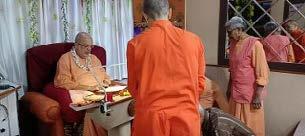




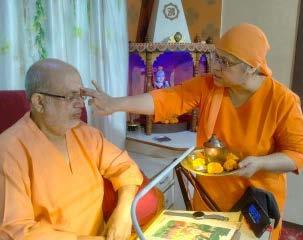



























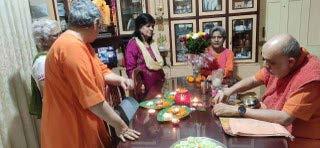

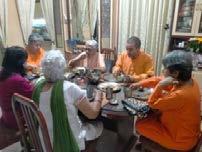
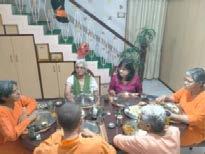























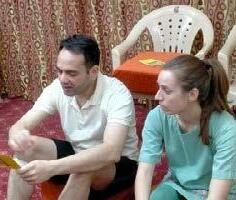
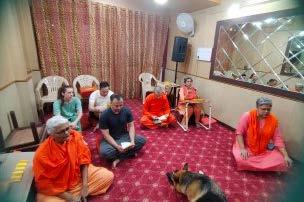
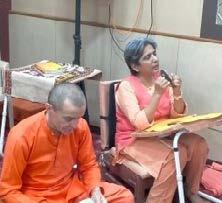














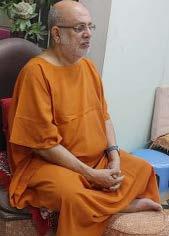





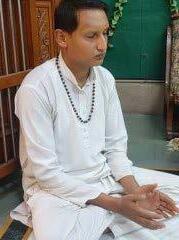








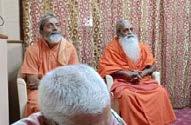


















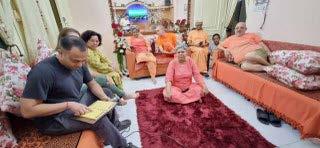









Visit us online : Vedanta Mission
Check out earlier issues of : Vedanta Sandesh



Join us on Facebook : Vedanta & Dharma Shastra Group
Published by: Vedanta Ashram, Indore Editor: Swamini Samatananda Saraswati
